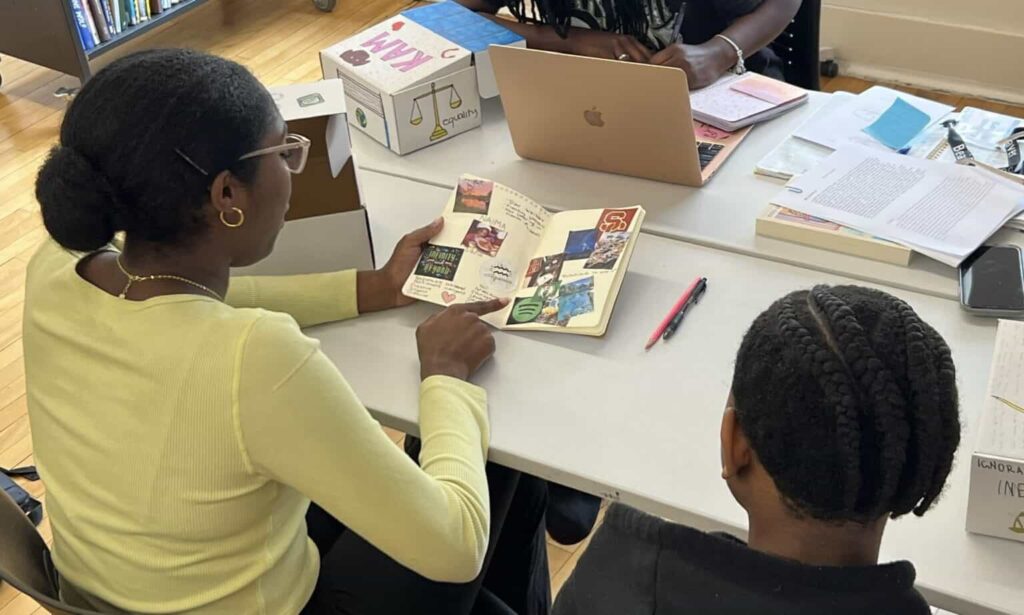Class: English 8
Grade: 8
Teacher: Kathleen Kosberg
It isn’t often that students studying English are encouraged to break writing conventions and write outside of the rules. However, after analyzing the free-flowing vignettes in the novel The House on Mango Street, English 8 students were challenged to do just that.
The House on Mango Street is a novel comprised of vignettes, short yet descriptive literary sketches. Students in English 8 dissected The House on Mango Street and analyzed how author Sandra Cisnero’s personal style invited readers into her world of experiences. To better understand how breaking the rules of grammar, punctuation, and sentence structure helped Cisnero tell her story, students were tasked with trying it out themselves.

First, students completed “artistic licenses” as a warmup activity. These licenses not only granted students permission to throw grammar out the window (for one assignment only, of course), they also required students do a bit of introspection. Prompts such as “something you’re very proud of” and “one very honest sentence about you and your life” were listed on each license, encouraging the class to be bold and honest as they took a step forward into the world of poetry. It was a social experience, with students processing the guidelines together, considering aloud what to include, and sharing their final products.

Students also created personalized boxes to store their keepsakes from the unit, including their finalized artistic licenses. The class had free rein in decorating their boxes but they were asked to consider including representations of what they are good at, what they care about, what problems they want to solve, and what gives them joy.
In the start of the unit, we created boxes of things we loved and problems we want to solve. We also took random facts about ourselves like birthdays and pet peeves and quotes we like and we put it on something important to us. I put it in my first tap shoe.
Adyana Gresham ’28

When it came time to write vignettes, the class had a list of prompts to work off of such as “where I’m from,” “discomfort,” ” something you deem to be unfair,” and “your plans for the future”. Each vignette was required to have multiple stylistic devices present, such as metaphor, rhyme, and alliteration. After completing their artistic licenses and personalizing their keepsake boxes, students were eager to flex their poetic muscles.
The whole point was to add meaning behind everything and intentionally bend the rules. If you didn’t want to capitalize your “I”s or have run off sentences, you can do that, but it has to have meaning. Even if you don’t write like that all the time, it’s nice to know how to do it.
Quinn Burke ’28
Many of the vignettes from this assignment are currently on display outside of Ms. Kosberg’s class. In one vignette, Recipe for Friendship, a student writes in the style of a cookbook recipe to detail how friendships can form. In another titled Gossip, the negative outcomes of constant gossiping are explored through metaphor and repetition. Each vignette is incredibly unique and personal, offering windows into the minds of various students.
I hope that students remember being excited and joyful – if nervous or apprehensive or shy – to acknowledge and celebrate the significance of their true individuality, to process what they deem to be unjust, to relive memories, and to articulate personal hopes and dreams, and to do all of this in a manner that is slightly (or very much) outside their comfort zone, via unrestrained (but also purposeful) language.
Kathleen Kosberg, MS English
More about this course: The 8th grade English course focuses on identity, with narratives involving adolescent characters reflecting on their interactions and experiences, responding to injustice, and questioning the status quo. Students respond to readings in a variety of modes: collaborative projects, personal reflections, expository essays, and creative compositions. The creative assignments allow individual freedom, stimulate imagination, and inspire risk-taking. Expository pieces prompt students to reflect on and respond to their readings and typically adhere to the five-paragraph format with the iterative process involving brainstorming, outlining, drafting, and revising. Students are encouraged to explore original modes of expression such as song, video, and visual arts. In general, emphasis is placed on development of creative problem-solving, collaboration, and study skills.
